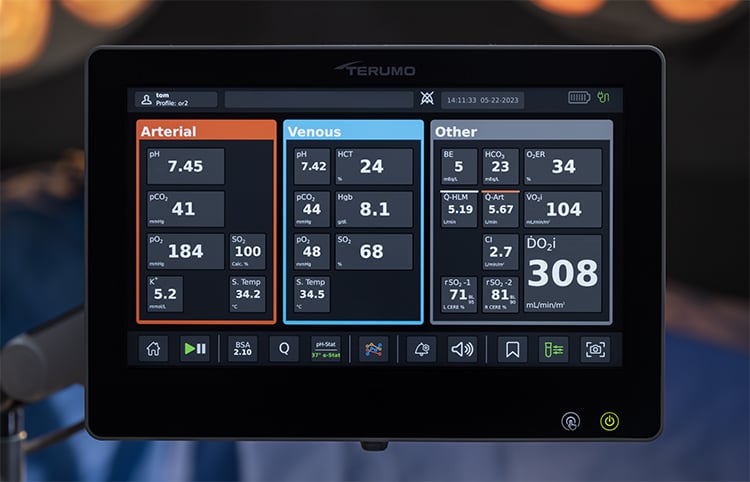Preserving Oxygen Delivery During CPB: A Proven Strategy to Reduce AKI and HL
Research shows that the largest area under the DO2 curve (AUC) is an independent risk factor for acute kidney injury (AKI).1 Managing indexed oxygen delivery (DO2i) in relation to oxygen extraction ratio (O2ER) has been shown to reduce the incidence of hyperlactatemia (HL) during surgery as well as to reduce postoperative serum creatinine, mechanical ventilation time and intensive care unit (ICU) stay.2
Terumo’s proprietary chemical fluorescent technology and device interconnectivity continuously display up to 22 vital patient parameters, including oxygen delivery (DO2), cardiac index (CI), area under the DO2i curve, O2ER, and measured flow. A substantial volume of peer-reviewed evidence strongly advocates for the monitoring and preservation of optimal levels of DO2 during cardiopulmonary bypass (CPB).1-17
The Value of Accurate DO2 Measurements in Relation to AKI
Research confirming the significant and serious impact of AKI to patient outcomes is extensive. Clinicians and hospital systems widely acknowledge the importance of minimizing AKI due to the substantial morbidity, mortality, and financial implications.

Reduce Mechanical Ventilation Time and Length of ICU stay
The management of indexed oxygen delivery (DO2i) in relation to indexed O2ER following CPB has been found to be more specific in terms of negative predictive value for hyperlactatemia compared to the use of cardiac index in relation to mixed venous oxygen saturation. That management can correlate with a postoperative better outcome especially in terms of serum creatinine, mechanical ventilation time, and intensive care unit stay.2

Minimize the Risk of AKI
Research indicates that the use of a GDP strategy aimed at avoiding a DO2 < 280mL/min/m2 on cardiopulmonary bypass (CPB) is effective in reducing the risk of acute kidney inury network (AKIN) stage 1 AKI after cardiac surgery.18
Take the Next Step
Contact us today for clinical or sales support!
References
- Oshita, T et al. A Better Predictor of Acute Kidney Injury After Cardiac Surgery: The Largest Area Under the Curve Below the Oxygen Delivery Threshold During Cardiopulmonary Bypass. J Am Heart Assoc. 2020;9: e015566. DOI: 10.1161/JAHA.119.015566.
- Condello, I, etal. Association between oxygen delivery and cardiac index with hyperlactatemia during cardiopulmonary bypass.
JTCVS Techniques. 2020; Vol 2: 92-99. - Dijoy, The History of Goal Directed Therapy and Relevance to Cardiopulmonary Bypass. J Extra Corpor Technol. 2015 Jun;47(2):90-4.
- 2019 EACTS/EACTA/EBCP Guidelines on Cardiopulmonary Bypass in Adult Cardiac Surgery European Journal of Cardio-Thoracic Surgery 00 (2019) 1–42 doi:10.1093/ejcts/ezz267.
- American Society of ExtraCorporeal Technology Standards and Guidelines for Perfusion Practice, February 2023*
https://www.amsect.org/Portals/0/AmSECT_Perfusion_S%26G_2023%20Ratified%20021023_Digital%20edition.pdf - American Society of ExtraCorporeal Technology Standards and Guidelines for Pediatric and Congenital Perfusion Practice, May 2019 https://www.amsect.org/Portals/0/AmSECT%20Documents/Pediatric%20and%20Congenital%20Standards%20and%20 Guidelines%20Final%20May%202019%20(1).pdf
- Kramer, et al. Acute Kidney Injury Subsequent to Cardiac Surgery J Extra Corpor Technol. 2015 Mar; 47(1): 16–28.
- Hayward A, et al. Oxygen Delivery in Pediatric Cardiac Surgery and its Association with Acute Kidney Injury using Machine Learning, The Journal of Thoracic and Cardiovascular Surgery (2022), doi: https://doi.org/10.1016/j.jtcvs.2022.05.039.
- Ranucci, M, et al. The Multifactorial Dynamic Perfusion Index: A Predictive Tool of Cardiac Surgery Associated Acute Kidney Injury. Perfusion. 2022 Vol. 0(0) 1-9 DOI: 10.1177/02676591221137033.
- de Somer, et al. O2 Delivery and CO2 Production During Cardiopulmonary Bypass as Determinants of Acute Kidney Injury: Time for a Goal-Directed Perfusion Management? Critical Care 2011; 15:R192.
- Elmistekawy, et al. Clinical Impact of Mild Acute Kidney Injury After Cardiac Surgery. Ann Thorac Surg. 2014 Sep;98(3):815-22.
- Ranucci M, Romitti F, Isgro G, et al. Oxygen Delivery During Cardiopulmonary Bypass and Acute Renal Failure After Coronary
Operations. Ann Thorac Surg. 2005;80:2213-20. - Dasta JF, Kane-Gill SL, Durtschi AJ, et al. Costs and Outcomes of Acute Kidney Injury (AKI) Following Cardiac Surgery. Nephrol Dial Transplant. 2008;23: 1970-1974.
- Alshaikh. Et al. Financial Impact of Acute Kidney Injury After Cardioac Operations in the United States.
Ann Thorac Surg. 2018 Feb;105(2):469-475. - Ranucci M, et al. Effects of Priming Volume Reduction on Allogeneic Red Blood Cell Transfusions and Renal Outcome After Heart Surgery. Perfusion. 2015;30:120-126.
- Ranucci M, Aloisio T, Carboni G, et al. Acute Kidney Injury and Hemodilution During Cardiopulmonary Bypass: A Changing Scenario. Ann Thorac Surg. 2015;100:95-100.
- Long, et al., Perfusionist Techniques of Reducing Acute Kidney Injury Following Cardiopulmonary Bypass; An Evidence-Based Review. Perfusion. 2014;30(1):1-8.
- Ranucci, M, et al. Goal-directed perfusion to reduce acute kidney injury: A randomized trial. The Journal of Thoracic and Cardiovascular Surgery. 2018 Nov;156(5):1918-1927.

